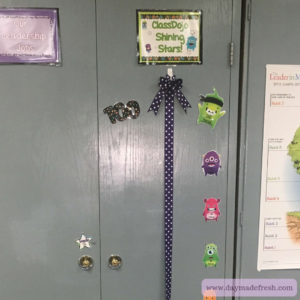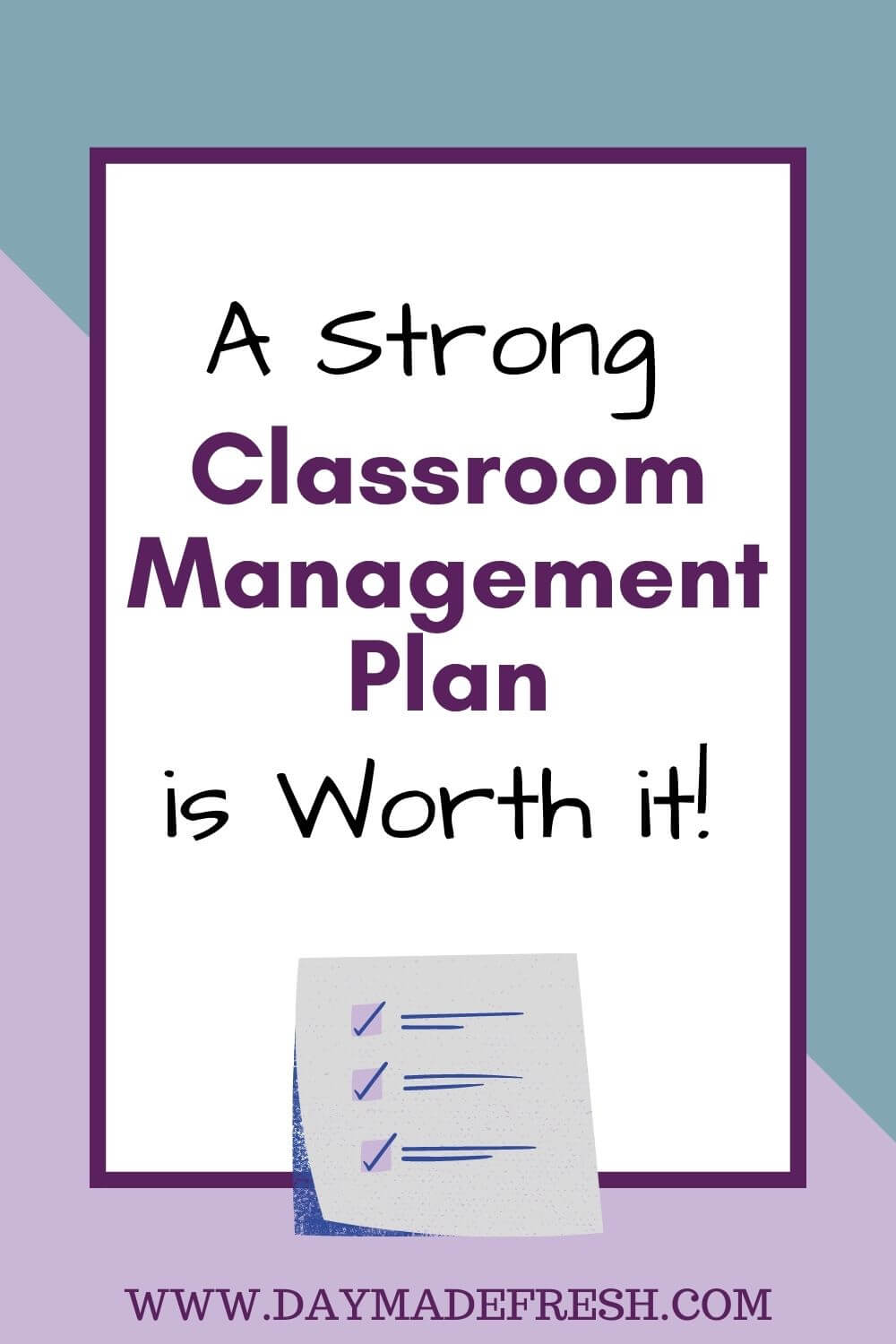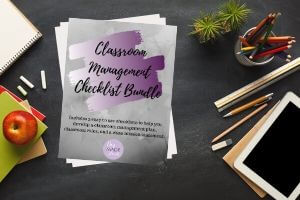How do you want your students to remember their time in your classroom? What impression do you hope people have of you and your class when they enter your classroom? Creating a classroom culture is a vital part of having a successful year with your students. One way to accomplish this is a strong classroom management plan.
Administrators expect that you will successfully create a classroom culture and it is often an area that is evaluated during teacher evaluations. To create the classroom culture you want, you need to develop a strong classroom management plan. This plan can include rules, procedures, positive and negative consequences for behaviors, and a system of rewards. Having a strong plan not only helps you develop the classroom culture you want, but can also refresh your classroom, help prevent negative behaviors, encourage risk-taking, and support student independence.
Creating a strong classroom management plan, Is Worth It!

When I first started teaching I thought I had the perfect classroom management plan. It was based on what my mentoring teachers had used and what I found online. I was sure my classroom would run smoothly and I would use this plan forever.
As I’m sure you’ve guessed I soon realized that my classroom management plan was something that would need to be adaptable. I’ve changed it every year as I’ve faced new challenges or discovered new techniques. I share this because I don’t want you to feel like your goal is to create the perfect classroom management plan right now. My hope is that I can help you begin a strong, adaptable classroom management plan that you can constantly work at making better.
This post contains some affiliate links for your convenience. Click here to read my full disclosure policy.
Classroom Culture and Environment
As with most things, you should start with the big picture. Instead of starting with your rules or procedures the best place to start is imagining what you want your classroom culture and environment to be like. Set a general goal for how you want students to feel in your classroom or what you want people to notice about your class when they see them in the hall or working.
This is going to be different for different teachers. There are some general expectations based on schoolwide rules, social norms, etc. but we also have the ability to set the individual tone for our classrooms. Some teachers love a loud, energetic classroom; while others prefer a peaceful, quiet classroom. You never know, you may want your classroom to be both; depending on what your students are doing.
Picture your ideal classroom, not just in general, but at all parts of your day. Once you have an idea of what you want. Start to work out what rules, expectations, or procedures you need to put in place to make that ideal classroom possible. This will be the start of your classroom management plan.
Class Rules
There are some different thoughts out there on how rules should be developed for a classroom. Some believe rules should be student developed and others believe that they should be developed by the teacher. What works for me is a happy medium. I develop my rules and expectations for the class and then I have each class develop a class mission statement, which I will talk more about later. So, stick with me :-)!
You can find examples of classroom rules all over Pinterest, but it is my belief that these should be a jumping-off point for you. You need to write your own classroom rules, so they fit your vision of your classroom environment and culture.



When I started out my rules were: Be Respectful, Be Responsible, and Be Safe. I would talk about what each of those rules meant and have students share examples of what it meant to be respectful, etc. These rules worked for my students that were well behaved, but I found that they were too open-ended for my students that struggled with their behavior. I then changed my rules to ones that were based on the Whole Brain Teaching model which I had seen in youtube videos. These new rules were even better. I did the hand motions with them and my students remembered them better. However, they were still too open-ended.
One year, I had four very difficult students that were consistent behavior problems and were making it almost impossible for me to teach. I was trying everything in my toolbox and it wasn’t working. My wonderful administrator brought in a behavior coach to help us develop plans for these students. She not only helped me develop individual plans for these particular students she also had me attend a professional development that was based on The Tough Kid book and Tool Box.
During the professional development they suggested that rules need to be concrete for “tough kids” so instead of just saying Be Safe I changed my rule to Be Safe: Keep Your Hands, Feet, and Objects to Your Self. It was amazing the difference this small change made.
Based on my experience to create a set of classroom rules that will work for you and your students you should:
- Keep to three to five rules.
- Make the rules concrete and easy to understand.
- Write them in a positive way. (ie: Listen when someone is speaking vs. No talking)
Read this post about creating clear concise classroom rules for more ideas.
Expectations and Procedures
My class rules are my general guideline, I find it is also beneficial to have expectations and procedures for each area of my room/school and part of my daily routine. I first look at my daily schedule then plan out what I want it to look like, sound like, and feel like. Then I decide what do I need to have my students do to make that possible. I’ve found that if I don’t set the expectations for a specific area the students will set their own and it won’t necessarily be what I’m looking for.

Our district uses the CHAMPS model; CHAMPS stands for Conversation, Help, Activity, Movement, Participation, and Success. This is a great framework to plan out your expectations and procedures for different parts of your day as well as explain it to your students in a concrete way. There are a lot of resources on Pinterest and online for CHAMPS. Check with your building or district and they may already have some school-wide expectations for areas like the hallway or recess.
Ready to develop your classroom rules? Check out my post about creating clear, concise classroom rules.
Class Mission Statement
As I shared earlier, I agree that it is important for students to feel ownership of the classroom and I give them that through the joint development of a class mission statement. After I have shared my class rules and as I go over expectations for different parts of our routine I begin working with my class on their mission statement. I’ve found that it usually takes 3 or more days to create this. It’s important to allow for ample class discussion and revisions.
A vital part of making this document worthwhile is referring to it frequently. I’ve also found it useful to have class meetings to discuss if we are following our mission statement or if we need to do something differently. This again puts more ownership of how the classroom runs on the students.
Read this post about creating a class mission statement in 7 easy steps.
Manage, Track, and Encourage the Behaviors You Want
Once I have my rules and class mission statement my next step is to plan how I will encourage the behaviors I want and discourage the behaviors I don’t want. I believe that children need to understand that there are always consequences to their actions and choices. These consequences can be either positive or negative.
I’ve always found it useful to have a system to track student behaviors. It doesn’t matter what system you use, but it is important to evaluate the system and make sure that it is helping you reach your ideal classroom culture goal. There are positives and negatives of each system and different teachers can use the same system in different ways. As long as you use your system with fidelity and it supports your classroom culture than it is the best system for you.

There is a multitude of ways to encourage good behavior and discourage poor behavior. I have tried a few different ways and I’ve found the best plan is to keep it simple. Kids love rewards and they will work for rewards, but I would caution you to make sure that rewards do not become the main focus of your plan.
The reason for this is that if the rewards become too important then students will only work or behave for rewards. Instead, I try to give a lot more verbal and written positive praise. In the end, rewards have their place in a classroom management plan, but they shouldn’t be the main focus.
Click Here to get Ready-to-Print and Editable Reward Tickets with No-Cost Rewards
The other side of rewards is negative consequences. What will happen when a student doesn’t follow your rules or your class mission statement. Hopefully, the majority of your class will not have problems, but I also believe that it is important to plan for the worst-case scenario as best as you can. I’ve found that having a strong plan, that’s developed a classroom culture, where students know the expectations and how they can do well is a huge help with dealing with the more difficult students. However, I have also found it’s not going to make every kid perfect (unfortunately).
Kids make mistakes and it is my belief that as an educator it is my job to help them learn from their mistakes. Kids don’t want to be bad, they need our help to learn the skill or skills they are missing. One way to help students when they misbehave is to have them use a reflection form or think sheet to help them think through what went wrong and what they need to do in the future (I use this for major behaviors, but it can also be used for minor behaviors). I also have an example apology letter to help students make restitution to peers or adults that they have wronged with their choices or behaviors.
If you plan to use time out, time away, or a cool-down spot as part of your classroom management plan it is important to have a clear procedure that students know how to follow, so you’re not trying to explain it when they are upset.
I discuss possible negative and positive consequences with my class when we are going over our plan at the beginning of the year, but I try not to make it black and white. There are always going to be instances that come up that will need to be handled a little differently, so you don’t want to back yourself in a corner with a setlist of consequences that students see in case you need to adapt your plan.
There is always the possibility that some students will need an individualized plan to help manage their behavior and help them learn how to do school, so you can keep your classroom culture strong. These may be based on IEPs, 504s, or what you feel a student needs to be successful. If you need to adapt things for an individual it doesn’t mean you’re compromising your plan it’s just adapting to meet the student or students where they’re at. I tell my class fair doesn’t mean the same otherwise everyone would have the same glasses, shoes, etc. Instead, fair is everyone getting what they need to be successful.
Want to know more? Check out this post about dealing with challenging student behaviors.
Communicating Your Plan
The last part of your classroom management plan is how you will communicate it to your students, their families, and other staff members. The majority of this communication will happen at the beginning of the year.
I have a one-page front and back explanation of my plan that includes my philosophy (why I have rules), my class rules, and the system I use to track and communicate student behaviors. I have a copy of the plan in my students’ communication binder (STAR Binder) that goes home each day and I send a copy home with a spot for the student and a parent or guardian to sign that says they’ve read and understood the plan.
I spend the first four or more weeks of school doing a variety of lessons to help students understand our rules, procedures, routines, and to develop our class mission statement. When I first started teaching I tried to complete this in just the first week. I’ve found it extremely beneficial to spend a lot more time on developing our classroom culture, otherwise, I have had to try and backtrack to fix it. This has worked, but it tends to be harder as students have learned bad habits. I’ve also found it helpful to review our classroom management plan after long breaks such as winter break or spring break.
When I notice my class as a whole is struggling with a specific skill or rule I will have a class meeting or discussion around what we’re doing, what we should be doing, and what we need to do differently.
I also connect my behavior tracking system to the rules and mission statement. In ClassDojo I word my positive and needs work points based on our class rules. This allows me to keep the wording fresh in students’ minds. For example, one of my positive points is “Followed Directions Quickly” and one of my needs work points is “Refused to Follow Directions.” These refer to my first rule which is: Follow Directions Quickly. This helps me to communicate and encourage the behaviors I want daily.
A comprehensive classroom management plan takes work up front, but the return on your investment is worth it. Your students will know what you and their peers expect of them. One of the best pieces of advice I have received is that I should never assume my students know how to do school because each child comes from a different background with different expectations. Instead, I treat each year as a clean slate and work with students to help them understand what they need to do to be successful at school.
Related Post: Why You Need A Classroom Management Plan
Creating a strong, adaptable classroom management plan will allow you to create the classroom culture you want. It will give your students clear expectations, so they can be successful and your classroom can run smoothly. If you have questions about developing a plan or if you would like to share your experiences developing your plan please contact me. I would love to hear from you!





